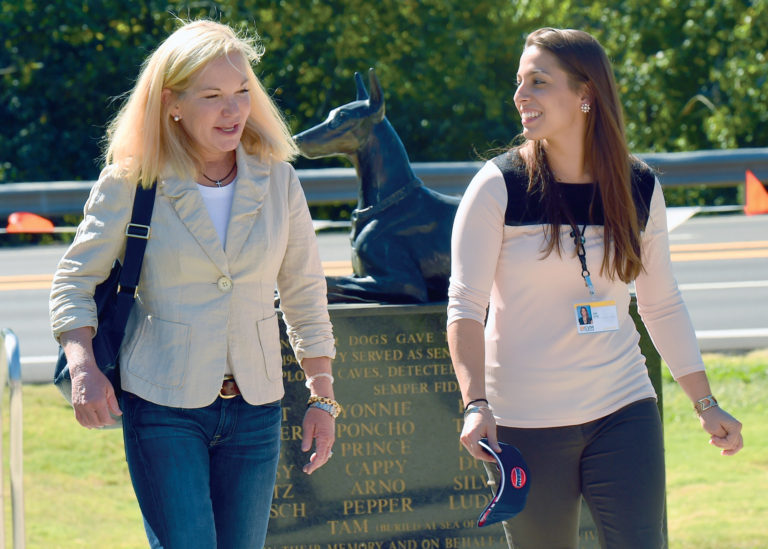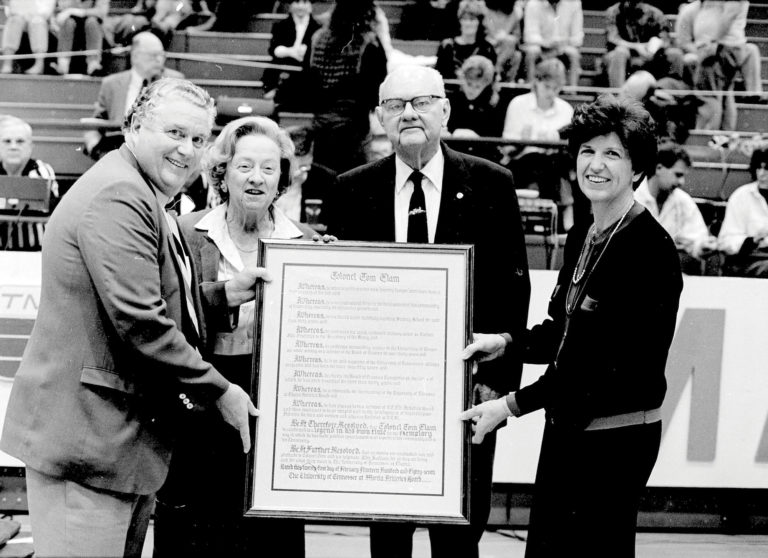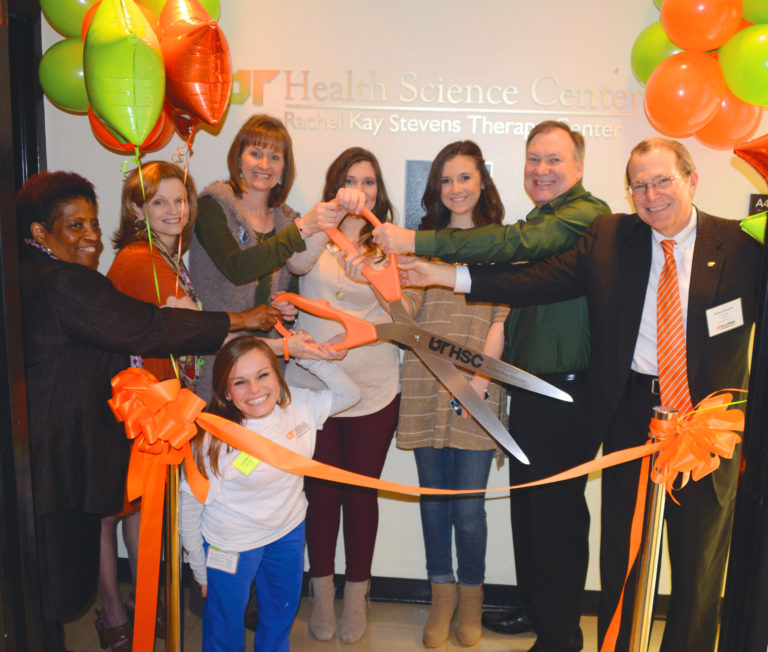Compiled by Chandra Harris-McCray with reporting by Josie Ballin, Terri Clark, Bud Grimes, Haylee Marshall, Peggy Reisser Winburne and Lauren Vath
For more than a century, the generosity and financial support of the ever-growing University of Tennessee family has powered the statewide system of UT campuses. And the people who give back prove there is no one-size-fits-all when it comes to transforming the future for generations ahead. While many have made large gifts, many, many more have made more modest, yet sustaining, gifts. Here are just a few of their stories.
UT Knoxville
Donor records go back only 40 years, but in this time more than 1.5 million donors have invested a total of $1.7 billion in cash gifts.

“What an incredible giving story the university has,” says Chip Bryant, UT Knoxville interim vice chancellor for development and alumni affairs.
“The power of many gifts coming together from our alumni and friends is inspiring. These thousands of donors have impacted our university but, most importantly, have changed the lives of countless students who have attended UT.”
In 1917, 751 students were enrolled on the Knoxville campus. Financial aid records show the first privately supported scholarship endowment was created in 1954. Because of many generous donors since then, today 92 percent of the more than 28,000 students on the Knoxville campus receive some form of financial aid.
Private giving has also helped make it possible for these students to learn from some of the best professors around the world. In 1974, the first privately supported professorship was created to support faculty excellence at UT Knoxville. In just the last five years, donors have funded an additional 95 endowments to support faculty awards and professorships.
“We can’t say thank you enough to the individuals who were the first to see a need at UT and were willing to support the need with their personal investments,” Bryant says. “Today’s donors are still seeing the many opportunities to support the university, and their investments will carry us through to the next 100 years and beyond.”
UT Chattanooga

Jack and Alice Lupton have provided more than $25 million in unrestricted funding to UT Chattanooga for the purpose of “unprecedented transformation.” The Lupton Renaissance Fund has supported scholarships, matching dollars for professorships, biological field research and programs to bring world-renowned scholars to campus.
Scott L. Probasco Jr., a long-time officer of the University of Chattanooga Foundation and legendary financial and civic leader, provided the vision and vital property to establish UTC’s South Campus for affordable and comfortable student housing. The Scott L. Probasco Jr. Distinguished Chair of Free Enterprise also was established to develop, through the educational field, a political, social and economic environment which will permit private enterprise to achieve its proper perspective in American economic life.
The late Irvine Grote impacted generations of graduates and personally established scholarships and departmental endowments allowing the UTC chemistry program to excel and prosper. Grote was one of the most distinguished American pharmaceutical chemists, receiving 75 patents for his inventions and assisting in the creation of internationally known brands Rolaids and Bufferin.
UTC also has benefited from long-term relationships with several Chattanooga-based philanthropic organizations, including Benwood Foundation, Lyndhurst Foundation and the Community Foundation of Greater Chattanooga.
The University of Chattanooga Foundation has supported academic initiatives and educational excellence at UTC since its creation in 1969. More than $114 million in financial support has been provided in scholarships to students, professorships for top faculty, the Patten Performing Arts Series, equipment for academic departments, matching funds for chairs of excellence and high-quality student housing.
UT Institute of Agriculture
The land-grant mission of the UT Institute of Agriculture is made possible by people who are generous—whether with time, talent or treasure.
That generosity strengthens the research, education, and extension outreach offered by the only UT entity with a presence in every county of the state.

Former Tyson CEO Donnie Smith (Agriculture, ’80) and his wife, Terry (Knoxville, ’81), wanted to invest in matters that would have global impact. That presented an opportunity to create a program that sprang from their passion for finding sustainable agriculture solutions worldwide, and the Smith Chair in International Sustainable Agriculture was established.
Scholarships help deserving students pursue their dreams of education—and now, veterinary students are among those with scholarship opportunities. While many scholarships are partial, occasionally, a donor is able to fund a full or nearly-full tuition gift. In 2017, the UT College of Veterinary Medicine will award its first student scholarship of that kind, thanks to Lee Ann Ingram, who is generously funding the first of several such annual scholarships for veterinary students.
The late Howard Wilkerson, a 1953 graduate of the College of Agricultural Sciences and Natural Resources, donated millions over his lifetime to support scholarships for animal and plant science students.
Howard Warmbrod (Agriculture, ’52, ’54) has donated to his alma mater for more than 60 consecutive years. He is a retired professor of agricultural education and considered by many in the discipline to be the “father of ag education.” His support has provided scholarships enabling others to have access to opportunities for educational success.

Waymon Hickman (Agriculture, ’52, ’56) has been a lifelong ambassador for UT. Whether providing sage advice in the political arena, supporting student scholarships or advocating for agricultural efforts throughout the state, Hickman’s tireless support for the UT Institute of Agriculture has come in a variety of areas. Initially, Hickman’s intent was to repay the scholarship he received as a student, yet his generous gifts today make it possible for generations of students to earn scholarships.
A public-private partnership to support education and leadership development for Tennessee youth exponentially multiplied the impact of gift dollars. State funds enabled the University to acquire Lone Oaks Farm in Hardeman County, and private and corporate dollars are developing the property into the state’s premier 4-H facility and conference center.
UT Martin
A little more than 100 years ago, Ava Gardner Brooks was a member of First Baptist Church in Martin and the donor of land that became the original Hall-Moody Institute. Since then, the name changed, the campus became known as the University of Tennessee at Martin, and the growing number and generosity of supporters have enabled UT Martin to become the university it is today and dream of the university it can be tomorrow.

Extraordinary generosity led Col. Tom Elam and his wife, Kathleen Elam, of Union City, to invest more than $7 million in the university during and after their lifetimes. Students, including those who transfer to the university and those who are the children and grandchildren of UT Martin alumni, continue to benefit. The Kathleen and Tom Elam Center is a testament to the couple’s lasting impact on the university.
More recently, the single-largest gift to the university in its history — $6.5 million from one donor – will help STEM (Science, Technology, Engineering and Math) education reach new heights. The future Latimer Engineering and Science Building will be named for its benefactor, the Latimer family of Northwest Tennessee.
UT Health Science Center
What is the opportunity cost of not securing philanthropic support? On the campus of the UT Health Science Center (UTHSC), that opportunity cost could be the difference between life and death.

The UT Health Science Center put the world’s largest mobile stroke unit into service on the streets of Memphis in summer 2016. It uses the most comprehensive scanning equipment for diagnosis and treatment with clot-busting drugs before the patient arrives at the hospital. Earlier treatment equates to better prospects for recovery. The unit was made possible by funding from key donors, including the Assisi Foundation, the H. W. Durham Foundation Inc., Jack Moore, and an anonymous foundation.
Earlier in 2016, the College of Health Professions’ occupational therapy department opened the doors of the nation’s only student-run, pro bono, pediatric occupational therapy clinic.
The Rachel Kay Stevens Therapy Center was named for an OT student who died shortly after starting classes. Classmates and faculty raised $25,000 to $30,000 through a letter-writing campaign to friends, family and supporters to supplement an initial donation from the Stevens family. They have now raised enough money to also fund a Rachel Kay Stevens Scholarship Award.

The College of Dentistry continues to expand its clinical reach across the state to address the needs of the working poor, thanks to generous donations from Delta Dental of Tennessee, the single-largest donor to the college with more than $15 million given for capital projects and scholarships by the company and its philanthropic arm, the Smile180 Foundation. The college opened a clinic in Chattanooga in September, joining similar UTHSC clinics in Bristol and Union City. Contributions for the clinics from Delta Dental have funded equipment, renovations and even transportation for some students.
UTHSC Executive Vice Chancellor and Chief Operations Officer Ken Brown says it’s impossible to overstate the importance of gifts to research initiatives and centers of excellence.
“A gift in support of basic science research advances lab work. When a donor endows a faculty chair, that gift allows a scientist to perform potentially life-saving research in the lab, such as finding a cure for HIV,” Brown says. “The impact of these types of gifts is felt for generations to come.”



